Home | Tours | Trip Reports | News | Team | Calendar | Links | Contact | Store | Mailing List
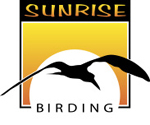 AUSTRALIA
AUSTRALIAQueensland
Photos & Trip Report
June 30 - July 6, 2009
Leaders: Gina Nichol, Steve Bird, & Roy Sonnenburg
TRIP REPORT>> PHOTO HIGHLIGHTS>>
Download trip report (pdf)>> Species List (pdf) >>
Day 1 - 29th June
Most of the group had been on the Birdseekers tour in Papua New Guinea and arrived in Cairns from Port Moresby in the evening. Bart was traveling in Australia and arrived in Cairns previously. Our guide Roy picked us up at the Cairns airport and brought us to our hotel where we settled in for the night in the midst of excitement and anticipation of our birding tour of Queensland.
Day 2 - 30th June
After breakfast we set off to explore the avian delights around Cairns. It was a gorgeous morning and from the hotel parking lot, we had our first Metallic Starlings, Common Mynas, a couple of Straw-necked Ibis across the street and some Magpie Larks. Our first birding stop was a mud flat area on the coast where a Beach Stone-Curlew was seen very well. A great start! We scanned the expanse toward the open water and found plenty of Silver Gulls, Sacred Kingfisher, White-faced Heron, Eastern Curlew, and Striated Heron. Our scanning was interrupted by the sound of a Mistletoebird perched on top of a tall tree near the beach and we had excellent views of this attractive bird, Australia’s only species of Flowerpecker. Looking back toward the sea we found a couple of Red-capped Plovers, Bar-tailed Godwit, and two close and very handsome Black-fronted Dotterels. Behind us, the trees above held Figbirds, Varied Honeyeater and Yellow Oriole and now there was a pair of Mistletoebirds displaying with each other in the canopy. We walked along the edge of some mangroves and soon found a Mangrove Robin sat on low a branch allowing good views. Further on, we added Brown Honeyeater, Spangled Drongo, Spotted Dove, and Peaceful Dove to our rapidly growing list. One last check of the mud flats yielded a Collared Kingfisher on a post and a Sacred Kingfisher that flew in and perched below it for a nice comparison. A few Eastern Reef Egrets were seen as well before we moved on to our next area, the Cairns cemetery. We drove in the main entrance and immediately found several Bush Thick-knees sat on and around the gravestones. A couple of Laughing Kookaburras showed well perched in a tree as we drove by and there were a few very colourful and active Rainbow Bee-eaters. A small flock of Nutmeg Mannikins was feeding in a mowed grass area and as we rounded the corner toward the exit, a Helmeted Friarbird was seen in a paperbark tree.
A White-bellied Cuckoo-Shrike was also seen in a distant tree and below that was a Varied Triller. Not bad for a cemetery!
We continued on to Centenary Lakes and were soon watching our first noisy Sulphur-crested Cockatoos flying around a tree across the road. A Brahminy Kite was also seen and some Double-eyed Fig-Parrots whizzed by and landed at the top of a tree allowing scope views in bad light. On the lakes we saw Australasian Darter, Pacific Black Duck and Australian White Ibis and the trees around held Dusky Honeyeater and Black Butcherbird. We walked along the edge of a woodland and peered in at an Australian Brush-turkey scratching for insects on the forest floor. A nice boardwalk led through a Pandanus Swamp Forest where there were incredibly large Paperbark trees (Melaleuca sp). The boardwalk ended on a street which wound around to the Cairns Botanical Garden where we enjoyed a drink before continuing back toward the lakes. Along the road we had a group of Metallic Starlings and a close Orange-footed Scrubfowl. Nearby White-breasted Woodswallows were circling overhead and a lovely bright blue Ulysses Butterfly fluttered through. A cracking male Olive-backed Sunbird was working the side of a tree and looked brilliant in the morning light. We entered the forest again and happened upon a group of Double-eyed Fig Parrots feeding on some fruits in a tree. They were well camouflaged but low in the tree and we enjoyed excellent views of them. Out in an open area there was a group of three Bush-Thick-knees under a small palm and a Yellow Honeyeater working a low branch. Across one of the ponds we had a Great Egret perched and we made our way around to another pond to see a Large-billed Gerygone at close range. Gina and Roy went to get lunch supplies and pick up Jill and Neil who were shopping for their own supplies and while they were out, the rest of the group had fabulous views of a confiding Forest Kingfisher. Our picnic lunch in the park included close visits by hungry Black Butcherbirds and after a short break we were off again birding. A Grey Goshawk was seen flying overhead and a Torresian Imperial Pigeon flew over as well.
We stopped in town to see a colony of Spectacled Fruit Bats in the trees just above a building. The sight was amazing with hundreds of these large, endangered bats hanging out right in the middle of the city! Our next stop was an obligatory sewage works (the mark of any good birding tour) which held Pied Stilts, Silver Gulls, Cattle Egret, and some Pacific Black Ducks. Across the street, a group of Nutmeg Mannikins were seen as well as a White-bellied Cuckoo Shrike. We traveled out of town to another area of sugar cane fields. A Collared Sparrowhawk was perched low in a gap between two fields and remained as we turned the vehicle around and looked into the gap again. On the other side of the road, we had Nankeen Kestrel perched on a high post and an Australasian Pipit on a mound of dirt. Looking back toward the cane, a few Crimson Finches were spotted and we enjoyed fine views of a bright red male as well as a few females.
We continued on in the heat of the day stopping at another pond where there were a hundred or so Green Pygmy-geese nicely showing their green iridescent backs. Australasian Darters were perched in the trees and two Radjah Shelducks showed well on the middle branch of a close tree. Across the pond two Nankeen Night-Herons were spotted – one adult and juvenile and there were some Brown-backed Honeyeaters in the trees above our heads. A lone Grey Teal was seen at the far end of the pond and a few more were found with the Pygmy Geese. There were many Welcome Swallows around and a few Pacific Black Ducks as well as some Rainbow Bee-eaters and a Sacred Kingfisher. Our next stop was in Yorkey’s Knob for a pit stop which gave us a chance to survey the ocean waters and spot some distant Brown Boobies out over the water.
At another pond, we had several Magpie Geese and our first Hardheads however distant. A quick stop at a culvert with Fairy Martins nesting underneath allowed flight views of the birds as their left their nests. The sun was getting low so we headed back to Cairns and walked along the waterfront esplanade. It was a lovely evening and despite the throngs of walkers, bikers, picnickers, etc, we found several birds along the shore including Great Knot, Eastern Curlew, Gull-billed Tern, Crested Tern, Pied Stilt, and Australian Pied Oystercatcher. Another spot further up the coast held Royal Spoonbills which were flushed by the parading marines jogging and chanting down the boardwalk. Fortunately, the other birds in the area where not so skittish and when we walked closer we had views of Australian Pelicans, a few White-faced Herons, Great, Little, and Intermediate Egrets, Australian White Ibis, more Crested Terns and an Australian Darter. There were hundreds of Rainbow Lorikeets in the trees all along the esplanade and moving in noisy flocks up and down the waterfront. Our final stop of the evening was at an open grassy area where we had more Magpie Larks, Nutmeg Mannikins, Willie Wagtails, and a confiding Golden-headed Cisticola. As it was getting dark, we headed back to the hotel for a lovely meal and review of the days excellent birding.
Day 3 – 1st July
After breakfast we were picked up at the hotel to go to the Cairns waterfront and to board our 32 meters Schooner Rig Catamaran for a cruise out to the Great Barrier Reef. It was a perfect day for an ocean cruise with clear blue skies and a light breeze. On the way to the waterfront, some of us caught a glimpse of an Australian Hobby on top of the hospital and when we reached the dock, there was a Peregrine Falcon on top of the mast of the ship. We settled in on the upper deck and as we motored out of the inlet we noted a few Crested Terns on the channel marker posts. After a couple of hours of motor sailing, the boat anchored just off Michaelmas Cay, a small sandy island surrounded by corals of the Great Barrier Reef. Now a National Park and protected seabird sanctuary, the island was buzzing with birds. We scanned the waters around the island as well as the shoreline where there were many Brown Noddies, Brown Boobies and hundreds of Sooty Terns that were busy nesting.
During the course of the day, some of us took advantage of the opportunity to snorkel and dive the reef and tour it in a large semi-submersible and in doing so we saw many colourful reef fish, sea slugs, giant clams, several Green Turtles, and a White-tipped Reef Shark. We also had time to look around the very active Sooty Tern colony which had several pairs with eggs and a few young chicks. At one point from the boat, we saw a Masked Booby flying toward the island, a good sighting for the trip. It was a fabulous day and on the way back we were serenaded by one of the crew who played guitar up on the foredeck and sang traditional Australian folk and modern songs. It was a lovely evening so when we returned to shore we decided to walk back to the hotel taking the route along the esplanade which once again was buzzing with people and birds. The walk yielded large numbers of Rainbow Lorikeets moving in every direction and along the shoreline we had Australian Pelicans, a White-faced heron, Silver Gulls, Australian White Ibis and many Masked Lapwings. As we were about to leave the waterfront and head toward our hotel we spotted both Varied Honeyeaters and Brown Honeyeaters.
Day 4 – 2nd July
After breakfast we checked the cemetery again and found the Bush Thick-Knees as well as Straw-necked Ibis, Rainbow Bee-eaters, and Willie Wagtails. Centenary Lakes had Orange-footed Scrubfowl, Spangled Drongo, Helmeted Friarbird, Rainbow Lorikeets, and Brown Honeyeater.
One of the mostly dried up ponds had a Little Kingfisher perched on some Lotus flower heads and this little beauty was well seen for several minutes. A Sacred Kingfisher also came in which was excellent for comparisons.
Then we headed out of Cairns along the Cooke Highway overlooking the beautiful coast of the Coral Sea. Our destination was the Atherton Tablelands and access to a variety of habitats including wet tropical forest, farmland and the dry Queensland interior. As we drove we scanned the sea for cetaceans and had a few glimpses of Bottle-nosed Dolphins porpoising in the offshore waters. Once we turned inland there were many Fairy Martins patrolling over open areas. In a mowed sugar cane field we saw several Cattle Egrets, a White-necked Heron and several Black-winged Kites which were soaring above the fields. We stopped in Mossman for a few supplies and then drove into the hills. Some raptors were seen circling so we made a quick stop on the road for a Black Kite and a juvenile White-bellied Sea Eagle. On the way back to the vehicle a couple of Yellow Orioles were spotted in some nearby trees. We continued up into the Rex Range, a wet tropics Global Heritage area and checked on overlook for a view of the valley below. Further on there was a fish farm with several ponds that held Little Egret, Pacific Black Duck, Little Pied Cormorant, a few Hardheads and a nice Forest Kingfisher perched on a post.
We arrived at Kingfisher Park lodge and were soon drawn to the feeders which had Yellow-spotted Honeyeater at very close range, several Crimson-browed Finches, and our first MacCleay’s Honeyeaters. We had some time before lunch so we birded around the car park and found Little Shrike-Thrush, a very bright Golden Whistler, a very handsome Spectacled Monarch, and a gorgeous Scarlet Honeyeater. There was also White-throated Treecreeper, Grey Fantail, and Dusky Honeyeater. Nice car park! We followed a small trail to an old orchard where there was a Pale-yellow Robin perched on an open branch, and several Brown Cuckoo-doves flew over as Bart spotted an Emerald Dove perched on a horizontal branch. A smart pair of Yellow-breasted Boatbills working along a tangle was quite striking and the sight of the male got a dance from Roy. You know it’s good when the guide dances! The trail led to an area near a stream where there was Rufous Fantail, Large-billed Scrub Wren, and Fairy Gerygone. Heading back toward the lodge we had good looks at Varied Triller and a Bar-shouldered Dove.
We enjoyed lunch on the lodge veranda while ticking our first Lewin’s Honeyeater and some of us had our first look at Grey-headed Thrush. In the afternoon we drove further into the mountains. A Swamp Harrier was seen from the vehicle but got away too fast so we continued on to a stop along the road where there was Northern Fantail, Chestnut-breasted Mannikin, and another Yellow-breasted Boatbill. Some female Lovely Fairywrens were spotted and soon we were looking at a pair including two stunning male Lovely Fairywrens which moved quickly along the bushes. We moved forward to head them off and Steve got excellent photos of this little beauty.
A Rufous Whistler showed while another Scarlet Honeyeater was seen in the canopy above. Continuing on we added Lemon-bellied Flycatcher and a Blue-winged Kookaburra that flew up to perch on a power stanchion. We entered some more open farm country and found our first Agile Wallabies in a field not far away. On the other side of the road a lotus-filled pond held Purple Swamphens, both Plumed and Wandering Whistling Duck, and some Comb-crested Jacanas. As we were about to leave a Spotted Harrier appeared and gave quite a show as it coursed over the wetland. Further on, we stopped for a group of Red-backed Fairy Wren females at the edge of an open field. A Spangled Drongo was seen in the background and some Sulphur-crested Cockatoos flew over. Our next stop was for a raptor perched in a tree which turned out to be a Brown Falcon. The bird took flight and was chased by a Black-winged Kite and the two proceeded to join in what can only be described as an aerial joust for several minutes. As the Kite attacked, the Falcon would roll over with its talons turned up in defense. It was amazing to watch as most of the attacks were from behind and yet the Falcon knew just when to rear up. After several minutes, the Brown Falcon admitted defeat by flying off. What a show! The only thing that could top that was an even bigger raptor and sure enough our next sighting was a huge White-bellied Sea Eagle soaring. It was a fabulous raptor day!
The next stop was at Abbatoir Swamp where the car park was again very birdy with White-throated Honeyeater, Brown Honeyeater, several Rainbow Bee-eaters, Peaceful Dove, and Yellow-faced Honeyeater. We walked a boardwalk into the swamp and in the trees along the way there was a close White-bellied Cuckoo Shrike and from the hide, we had a couple of Forest Kingfishers and a Blue-winged Kookaburra. As we were watching those, a White-browed Crake called from behind the hide and we spent several minutes searching for it but it did not show. Continuing on, we stopped and walked another trail between some cane fields to look for Blue-faced Parrot-Finch. We found their favored food and some people in the front of the group saw some birds fly off but the birds were not cooperating. A few Silvereyes showed well and Kevin found a Victoria’s Riflebird working on a dead stump – a nice consolation for missing the Parrot-Finches.
We continued driving and reached another area where a Pheasant Coucal flew off in front of us. A couple of young Lemon-bellied Flycatchers on a fence gate gave us a bit of an identification challenge and further on a pair of White-cheeked Honeyeaters showed well near another fence. In a distant tree there were a few Scaly-breasted Lorikeets and White-bellied Woodswallows. While on the way back there was a Grey Goshawk perched on a power stanchion and we had Brown Goshawk and Whistling Kite perched. We returned to the lodge and some of us immediately went to the orchard to see a pair of Papuan Frogmouths in a tree. At dusk, we walked to an open area scoping an Australian Owlet Nightjar peering out of its tree hole.
Then our guide spotlighted a Masked Owl coming out of a hole in a large tree. The bird perched and then called to another tree which held three young Masked Owls and they began to appear as well. Yet another tree held another Masked Owl for a total of six for the evening! Back at the lodge, our host showed us a pair of White-lipped Tree Frogs and some Desert Tree Frogs that spent the evening under the roof of his cottage. We enjoyed a lovely dinner under an open air canopy and just as we were about to go back to our rooms a Northern Brown Bandicoot appeared under the bird feeders as well as an Australian Bushrat.
Day 5 – 3rd July
After an early breakfast we drove to Daintree Village arriving by dawn ready for our 6:30 AM boat ride on the Daintree River. It was a misty morning on the river and our first bird was an Azure Kingfisher near the dock. We started our cruising staying close to the bank where a pair of Shining Flycatchers showed well at eye level in some trees overhanging the river and a Large-billed Gerygone was found. A Helmeted Friarbird was spotted on the treetops and a Striated Heron flew across in front of us. There were plenty of Welcome Swallows around winding in and out of the fog and as we slowed down to check a sandy area onshore where there was an “intermediate” Masked Lapwing and an Australian Pipit. A pair of Hardheads flew by and as the fog was lifting we had a sighting of the rare Great-billed Heron. A Nankeen Night-Heron was seen perched on some low vegetation and some Figbirds and Yellow Orioles were seen in the higher branches. Another Great-billed Heron flew in and perched on a tree ahead of us before taking flight up the river. Continuing on we had Little Shrike-Thrush, Spangled Drongo and Grey Whistler, a Little Egret (the form without the yellow toes), Black-fronted Dotterel and a tree full of Cattle Egrets as well as a couple of Little Pied Cormorants with them. A Brown Goshawk quickly flew off its perch but a nice male Australian Darter was much more confiding allowing us close views and photos. As we drifted close into a group of overhanging trees we got superb views of a confiding pair of Papuan Frogmouths perched together. Nearby a Whistling Kite was flying above and a White-faced Heron was also seen. We motored to an area of mangroves where there was Leaden Flycatcher, Dusky Honeyeater, another Grey Whistler and another Papuan Frogmouth. An Australian White Ibis took flight just before we spotted a Little Bronze (Gould’s) Cuckoo perched high in a tree where we then maneuvered the boat around to try and get a better look at it. On the way back we had both male and female Olive-backed Sunbird and very close looks at a Forest Kingfisher perched out over the river on a fallen tree. As we approached the dock, an Australian Hobby was seen perched on a dead tree.
We took a few minutes for a coffee break at a nearby restaurant which allowed us fantastic views of two Pacific Bazas which flew in and perched in the trees nearby. On the way back toward the lodge we stopped at a fish farm which had plenty of Pied Stilts and a White-bellied Sea Eagle perched in a low tree at the far edge of the ponds. Some Fairy Martins bathing in a puddle allowed close views from the van and soon we were winding our way back up the mountains to the lodge for a picnic lunch.
In the afternoon, we drove up to Mount Lewis picking up a Bassian Thrush, Yellow-throated Scrub Wren, and Grey Fantail alongside the road on the way. We arrived at the parking area which was very birdy and added Bridled and White-cheeked Honeyeater as soon as we got out of the van. As we walked up the track, several Atherton’s Scrubwrens showed well, not the least bit phased by our presence. One area had a group of five Chowchillas scratching amongst the dead leaves on the ground allowing us great views of males and females. As we ascended the trail we had Mountain Thornbill, Eastern Spinebill, Grey Shrike-Thrush and Brown Cuckoo-dove and an Australian Brush-turkey that was sunning itself on the trail. There were several Yellow-throated Scrub Wrens on the path as well. Soon after we had turned back, Kevin snapped his fingers and motioned us to come forward to see what turned out to be one of our best birds of the trip a superb looking male Golden Bowerbird working a tree and eating fruits. The bird was a stunner and we had excellent views as it worked up and down tangles and in low branches for several minutes feasting on small berries. Continuing down we had a Pied Monarch that quickly disappeared, and a difficult Tooth-billed Bowerbird. Another small group of Chowchillas had a pair of Fernwrens with them and we enjoyed amazingly close views of the birds on the edge of the trail. As we arrived back at the van, a few Topknot Pigeons flew over continuing on instead of landing as we hoped.
We arrived back at the lodge in the late afternoon and checked a small pond near the orchard where an Azure Kingfisher was perched and an Orange-footed Scrubfowl was working the muddy edge. Down at the little stream, several birds were coming in to bathe including Pied Monarch, a couple of Rufous Fantails, Grey Fantail, Lewin’s Honeyeater, Grey-headed Robin and Yellow-faced Honeyeater all showing well. On the way back, a Wompoo Fruit-dove got away before most were able to see it. By now it was dark so we walked back to the lodge for dinner.
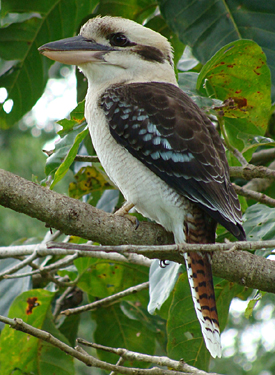
Laughing Kookaburra. An Australian icon.
Photo by Gina Nichol
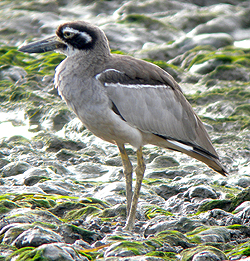
Beach Stone-Curlew
Photo by Steve Bird
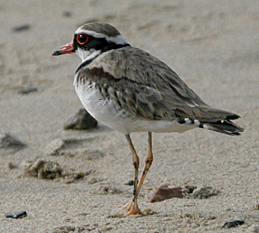
Black-fronted Dotterel
Photo by Steve Bird
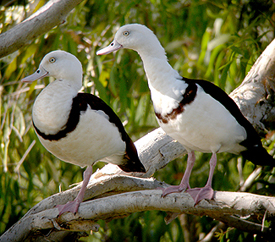
Radjah Shelducks
Photo by Steve Bird
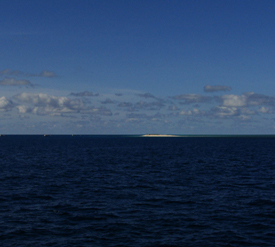
Michaelmas Cay from afar
Photo by Gina Nichol
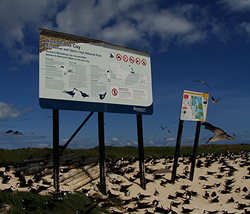
Michaelmas Cay
Photo by Gina Nichol
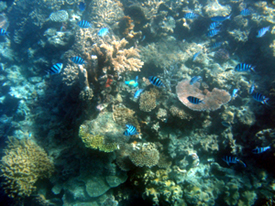
Sea life on the Great Barrier Reef
Photo by Gina Nichol
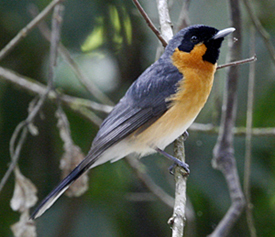
Spectacled Monarch
Photo by Steve Bird
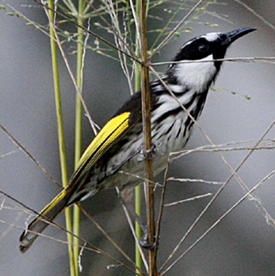
White-cheeked Honeyeater
Photo by Steve Bird
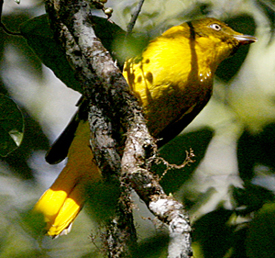
Golden Bowerbird
Photo by Steve Bird
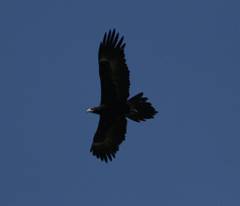
Wedge-tailed Eagle
Photo by Steve Bird
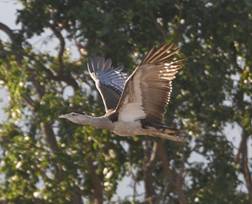
Australian Bustard
Photo by Steve Bird
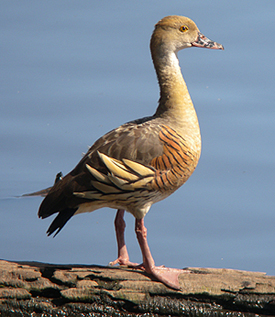
Plumed Whistling Duck
Photo by Steve Bird
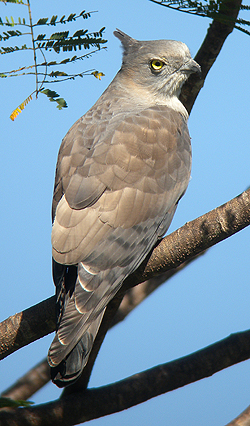
Pacific Baza
Photo by Steve Bird
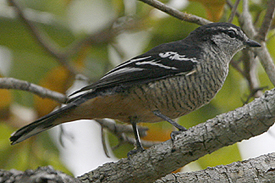
Varied Triller
Photo by Steve Bird
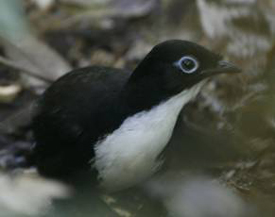
Chowchilla
Photo by Steve Bird
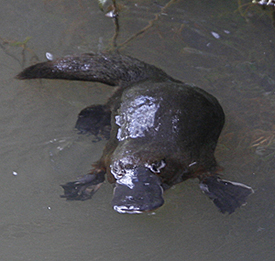
Duck-billed Platypus
Photo by Steve Bird
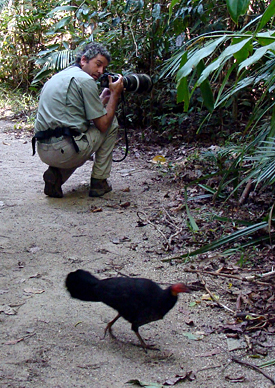
Bird photography in Australia
Photo by Gina Nichol
More photos>>
Day 6 – 4th July
This morning some of us met on the veranda before breakfast to see the Spotted Catbird come into the feeder. The bird arrived but was very wary. Fortunately, a pair showed very well later while we were having breakfast. Our pre-breakfast walk through the gardens yielded Pied Monarch, Scarlet Honeyeater, Yellow-spotted Honeyeater, Golden Whistler, Grey Whistler and Graceful Honeyeater. A Brown Cuckoo-dove was seen in the orchard as were a few Rainbow Bee-eaters and here some of us had a chance to catch up with a Wompoo Fruit-Dove that showed high in the trees. After breakfast, we set off in the van stopping at the cane break area where we finally got on some Blue-faced Parrot Finches feeding on seeds. Roy drove us through savannah habitat and we got out of the vehicle a few times to bird some open grasslands. Here Australian Magpie and Nankeen Kestrel were becoming common. More unusual was a Red-backed Kingfisher seen perched on a fence, and nearby on another post was a Brown Falcon. Pied Butcherbird was seen and a Crested Pigeon showed well on a wire. The wires also held Blue-winged Kookaburras. A stop at the Carbine Roadhouse for a snack produced Blue-faced Honeyeaters in the trees above and yet another look at Pied Butcherbird. We moved across the street where a group of Apostlebirds were feeding in a fruiting tree, and a couple of Great Bowerbirds allowed us all excellent views.
Our next stop was on an open dry grassland area near some ponds. As we walked out on the track a Royal Spoonbill flew over and a juvenile Peaceful Dove was seen perched close to the track. A small group of trees at the edge of the pond held a Restless Flycatcher, new for the trip, and from an open area overlooking the pond we saw Australasian Grebe, Little Pied Cormorant, and Pacific Black Ducks. A White-throated Honeyeater was seen in some trees near the edge and a little further away a Forest Kingfisher was perched. As a Brown Goshawk was seen soaring over the lake, an Australian Reed Warbler called from some reeds on the shoreline but eluded being seen by most of us.
We moved on to another pond in the dry farmlands where several Double-barred Finches were feeding on a bank. A couple of Red-tailed Black Cockatoos flew over the hills in the distance and we then had great views of a confiding Brown Treecreeper working along the trunks of the low trees nearby. Suddenly a commotion from a group of four Red-tailed Black Cockatoos caught our attention and as we watched, an adult Wedge-tailed Eagle appeared above the tree tops. The bird flew up a few times allowing great views as the Cockatoos continued on over the hills.
We enjoyed a picnic lunch alongside a stream in the Brooklyn Wildlife Sanctuary and then began to make our way back through the countryside. A group of eight Galahs feeding on the ground close to the road were a gorgeous sight to behold. A little further on four Squatter Pigeons also close to the road allowed good views as well. We stopped again to bird at the small pond and had nice views of a Striated Pardalote that was calling from the low trees, followed by a group of Pale-headed Rosellas that landed in a tree right in front of us and as we walked around the pond we found a few Black-throated Finches, White-throated Gerygone, and had quick looks at a Grey-crowned Babbler. Our next stop was to look at a tree full of hundred’s of Blue-faced Honeyeaters and then we were on bustard watch as we drove through the grasslands. We scanned the tall grasses and soon saw the telltale head of a bird, its body hidden in the tall grass. We waited for it to move, and after a few patient minutes an Australian Bustard walked out of the grasses and showed well. The bird then flew across the road behind us and disappeared. Just ahead was another Australian Bustard near a fence. It appeared to want to cross the road but its path was blocked by the fence so the bird took flight and crossed in front of us – an amazing view of Australia’s largest flying bird!
Back out to the main road, we had a very close Nankeen Kestrel on the ground, while a quick look on another side road led to a stop for a Brown Falcon on a fence post. Our attention was diverted again by yet another close Australian Bustard that flew across in front of us. What a day! As the sun set, we made our way back to the lodge for our final dinner at Kingfisher Park.
Day 7 – 5th July
This morning, our bird walk before breakfast yielded a selection of Honeyeaters including Lewin’s, MacCleay’s, Yellow-spotted, Scarlet, and Dusky, all on one flowering Eucalyptus tree. There was also a Pied Monarch and we had good views of a Wompoo Fruit-Dove in the scope. We also had both male and female Yellow-breasted Boatbills, a Laughing Kookaburra and a Little Shrike Thrush.
After breakfast, we bid farewell to our hosts and were on our way to the Atherton Tablelands for the last days of our tour. Forest Kingfishers were seen during the drive and in a residential area we had some Great Bowerbirds, Bar-shouldered Doves, Nankeen Kestrel, and a Collared Sparrowhawk that flew over and disappeared quickly. In Mount Molloy, a group of Red-winged Parrots showed well on top of a tree including a nice view of the male showing its red wings. We drove out toward Lake Mitchell passing Intermediate Egrets in the wetlands along the lakeshore. At a gate which led to a causeway there were Golden-headed Cisticolas working in some grasses. While watching the Cisticolas, a Black-faced Cuckoo-Shrike was also seen and a couple of Australian Magpies were around. We drove into an area that had an open view of the lake which held Little Pied Cormorants, Australian Darters many Magpie Geese, and several pairs of Australian Black Swans.
A Swamp Harrier flew over as we walked through another gate and further along the causeway. A group of Red-backed Fairy Wrens showed in some nearby scrub and a Pheasant Coucal flew through quickly. Fairy Martins and Welcome Swallows were flying over the lake and we scoped some Comb-crested Jacanas walking on the lily pads.
Our next stop was near a golf course where about three dozen Eastern Grey Kangaroos were sitting in the shade just off the fairway. We stopped for supplies in town and then traveled on stopping for a tree full of Red-tailed Black Cockatoos not far from the road. We passed by several farm fields around Atherton and searched through the many Sarus Cranes feeding to get a good views of the similar looking Brolga. A Wedge-tailed Eagle was perched on a fence post along one of the fields and some Australian Pipits were easily seen. Golden-headed Cisticolas were also seen on the fences and there were flocks of Nutmeg Mannikins around. Another field held several Straw-necked Ibis, some Masked Lapwings and another Spotted Harrier.
We enjoyed a picnic lunch in a park and then moved on to Hasties Swamp National Park which had a pond that was full of birds including Purple Swamphen, Dusky Moorhen, and Magpie Goose. There was a Bush Stone Curlew under some trees and then we went into a hide overlooking the water which had hundreds of Plumed Whistling Ducks. The pond also had Little Black Cormorant, Australasian Grebe, a few Pacific Black Ducks, Hardheads and Eurasian Coot. Outside the hide, a Brown Falcon was posing on an open perch allowing for good views and photos.
We moved on to the village of Malanda picking up Crested Pigeon on the power lines in town. Once settled into our accommodation we went back out again in the afternoon to a forested area which held Tooth-billed Bowerbird, a female Victoria’s Riflebird, a male Eastern Whipbird, and a Mountain Thornbill. The sun was beginning to set when we arrived at the Bromfield Swamp overlook where we watched as some Sarus Cranes flew out. We were slightly distracted by some activity across the road where a Brown Gerygone and Large-billed Scrub Wren were foraging Roy laid out cheese, crackers and wine and we enjoyed the lovely evening watching the spectacle of the Sarus Cranes and Brolgas flying into the crater landing gracefully and some of them even finishing with a dance. With the sunset behind us, the scene was nothing short of magical! Later in the evening we had dinner at an historic inn and then made our way back to the hotel for the night.
Day 8 – 6th July
This morning before breakfast we went to an area to look for fabled Platypus. There were a few turtles around but no sign of Platypus perhaps because of the chill of the morning. On the way back we stopped in town for a few Pied Carrawongs and this turned out to be a very productive stop as it also included views of Australian King-Parrots bathing in the dew on some treetop leaves and some big flocks of Little Corellas that flew over.
After breakfast, we visited Curtain Fig Tree Park, a tract of Mabi Forest which holds the Tablelands most famous tree – the curtain fig. We were greeted by a Pale Yellow Robin as we walked into the boardwalk that led to the big tree, a Green Fig which has strangled two other trees over time creating a massive curtain-like structure. A Grey-headed Robin was seen on the ground below the boardwalk and there were a few Brown Gerygones in the trees just above eye level. Our next stop was near a bridge over Peterson Creek where we checked a quiet pond and to our amazement and delight found a Platypus that showed very well surfacing several times allowing photos. We were thrilled to have such good views of this elusive animal – an Australian icon!
Our next stop was at Lake Eacham which was fairly devoid of birds except for an Australian Darter perched on the far shore. A Crimson Rosella flew over and was relocated on a perch for scope views and Grey Fantail and Mistletoebird were seen in the trees as we walked the road. There was a bit more activity at our next stop overlooking another lake. As we walked from the car park, an Eastern Spinebill was seen working a bush, and over the lake there were several Welcome Swallows while a small group of Pacific Black Ducks approached as we arrived at the lake shore. Further out, we could see our first and only Great Crested Grebes of the trip and nearby an Australian Little Grebe. A woodland track on the hillside above the shore revealed a Musky Rat-kangaroo and a male Eastern Whipbird scratching in the leaves at the base of a palm right next to the trail allowing views at less than a meter.
We enjoyed a picnic lunch and then drove through some farm areas. At one point, a Forest Kingfisher flew along side us keeping up with the vehicle for several hundred metres. We stopped at the Cathedral Fig Tree and were greeted by the ubiquitous Australian Brush-turkey in the car park, although getting photos of this bird seemed problematic for Steve. The trail to the fig held Brown Gerygone, Large-billed Scrub Wren, and Little Shrike Thrush. Another Musky Rat-Kangaroo was seen and we had good views of Tooth-billed Bowerbird and a female Victoria’s Riflebird in the trees above.
In the afternoon we headed back to Cairns stopping at Goomburra Park for our last birding of the tour. Some fruiting trees held a good number of Brown Orioles and a bright male Figbird. A couple of Double-eyed Fig Parrots flew in and scope views revealed their superb colours. Some Metallic Starlings were around and a Brahminy Kite flew over, while a very confiding Laughing Kookaburra allowed close approach and photo opportunities. Later we checked into our hotel and enjoyed a nice dinner. We said goodbye to our excellent host and guide Roy with memories of many great birds seen on our Queensland extension.
It was a pleasure leading this tour under the expert direction of Roy and with a group of birders who were flexible, easy going, fun, and whose positive karma was rewarded with many excellent sightings of wonderful birds and Platypus! Thank you all for a great trip!
Steve & Gina
